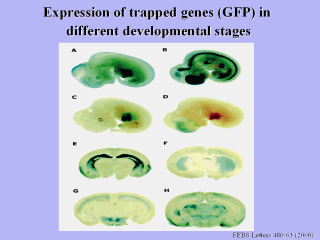 |
Expression of di°erent
gene trap lines visualized by beta-gal activity. (A-D) show a lateral view
on day e12.5 embryos. (E-H) show a view of cross-sectioned pn9 mouse brains.
(A) Gene trap line 6B-4 has a widespread expression throughout the embryo,
while the dorsal CNS shows the highest activity level. (B) Gene trap line
9A-33 demonstrates very strong restricted expression in the tegmentum, in
the ventral metencephalon and the spinal cord. The most dominant activity is
located in the cortical hemispheres. Additional expression domains are heart,
liver, spinal nerves and limbs. (C) Gene trap line 3C-40 reveals restricted
activity in the developing liver. (D) Gene trap line 2C-98 has restricted
expression in the dorsal telencephalon, the anterior tectum and the eye. (E)
Gene trap line 3C-178 shows strong expression in the hippocampus and weaker
activity in the cingular and piriform cortex of the early postnatal brain.
(F) Gene trap line 6A-126 exhibits restricted expression into the striatum
and a fainter level of activity in the subventricular zone of the cingular
cortex. (G) Gene trap line 9A-196 expression is located in the
subventricular zone of the somatosensory cortex and the hypothalamus. (H)
Genetrap line 7B-79 shows, beside regional restricted expression in the
cingular and motor cortex, a broader activity in the thalamus. |
